| Shortcuts to other sections | ||||
| Stamps per sheet | None ever used? | Statistics | Substituted clichés | 3d Booklets |
According to Philbrick & Westoby (1881, page 347), "The sixpence is better executed, being lithographed from an engraving on copper, while in the threepence this is not the case."
They had only seen the 6d and the later 3d brown, but the production of the 6d is relevant to the 3d green and later 6d substituted clichés.
The 3d green stamps I have seen so far with small 'THREEPENCE' are controls 2207, 2217 and 8442 which led me to a theory.
Raymond Lister (1961) gave a detailed description of the Universal Private Tel. Co. stamps produced by Waterlow & Sons.
Since these were also produced by Waterlow, I wondered if they were done the same way.
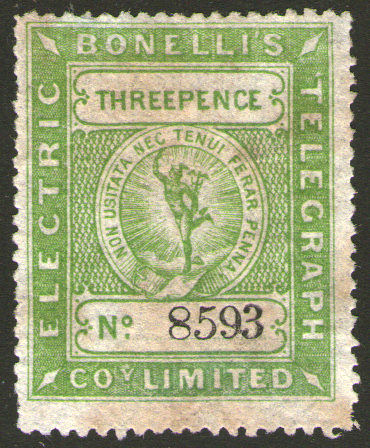 |
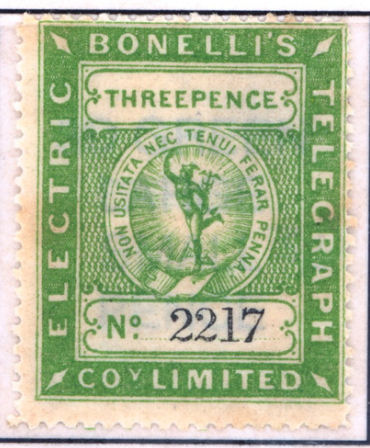 |
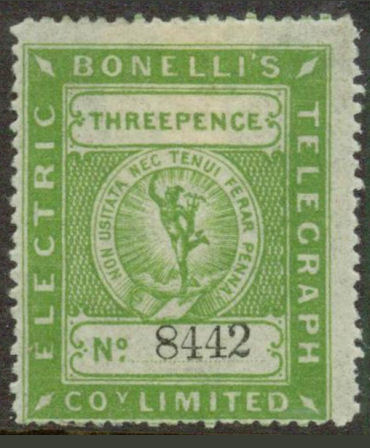 |
| Normal for comparison. | Courtesy of Mark Gibson. | Courtesy of Roger de Lacy-Spencer. |
These stamps were printed by Waterlow and Sons who also printed Universal Private Telegraph Company stamps in 10 rows of 10.
Those had numbers with last digits starting at '1' and ending with '0' on each row.
With the Universal Private Telegraph Company stamps, any variety was repeated every 5th stamp. I found that the same applies with the Bonelli stamps and the
small 'THREEPENCE' is on every stamp with a last digit of '2' or '7'.
This would imply that nearly 45% of horizontal pairs of these would have a large and small type (L&H Rarity R5).
This last prediction is quite extraordinary, I can only assume that all pairs of the 3d green are very scarce (it is the only value I do not have as a block of 4).
The theory should be easily disprovable.
Anyone have one with control ending with '2' or '7' that is NOT small 'THREEPENCE' ?
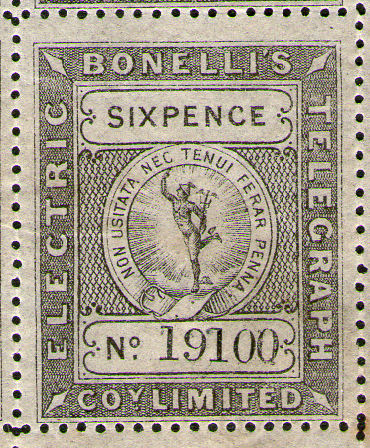 |
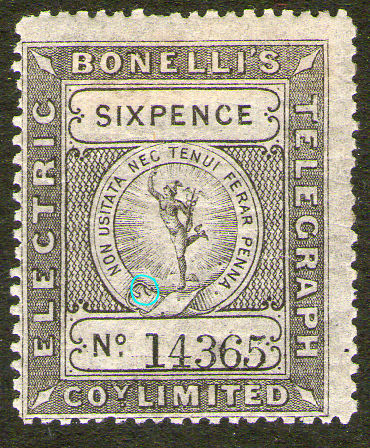 |
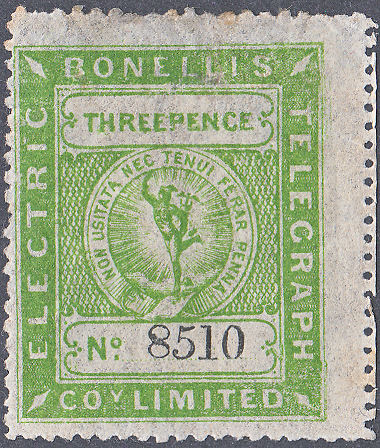 |
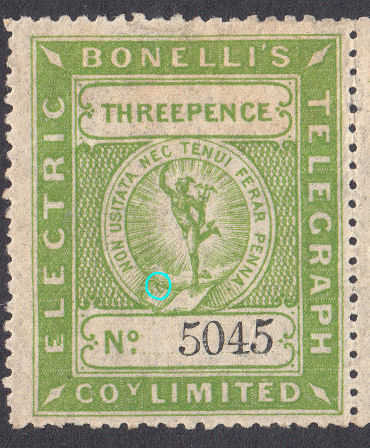 |
| One of mine. | One of mine. | One of mine. | Courtesy of Steve Lawrie. |
The scratch on the buckle occurs on all of the 6d stamps and all of the 3d stamps with the last digit of the control a '0' or '5'.
It does not occur on the 9d or 1s values. It is not on any other 3d or 6d stamps either.
This follows the pattern of the U.P.T. stamps produced by the same printer.
The other flaws (not involving the value tablets) are the same on the 3d green and 6d.
The transfer block of 5 is consistent with it being a copy of the 6d with the value cleared out and replaced by hand-inscribed "THREEPENCE" on each, with minor variations.
The 9d and 1s values were not done that way, they have different flaws.
Langmead and Huggins say the Bonelli sheets were 8 x 10 stamps but I do not believe this, the evidence does not support it.
Also I have a bottom right corner block of four 6d stamps with serials 19089, 19090 / 19099, 19100. I cannot believe the sheet started with 19021,
when my only block with selvedge at the top appears to start at 4001. Both blocks show clearly that it was 10 stamps per row.
Anyone have any complete sheets ?
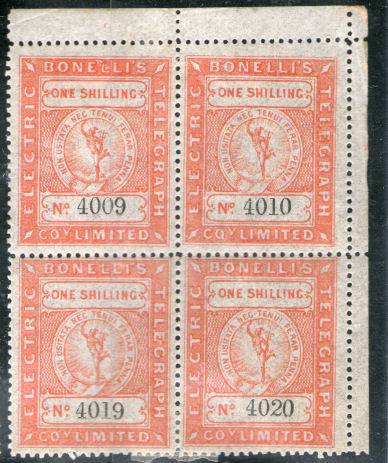
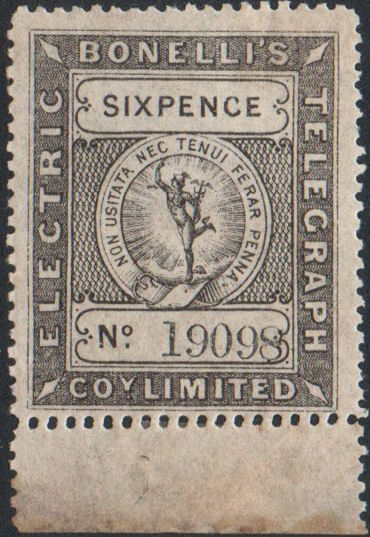
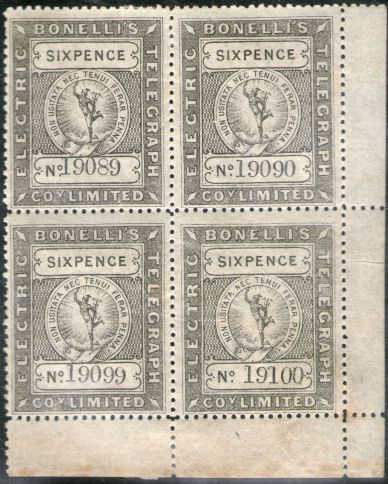
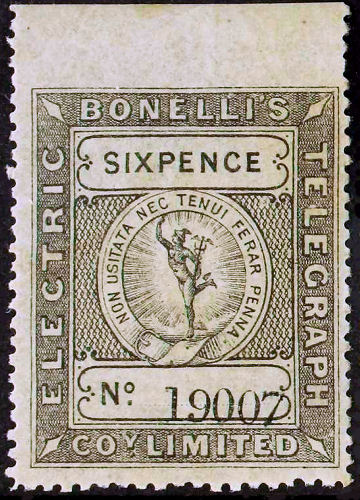
The 1/- block is perforated along the top row of stamps and the sides. The 6d block is perforated at the bottom and right side, but a stamp from the top row of the same sheet is imperforate at the top.
For the sake of interest, the 6d on the left of the 6d block is a substituted cliché with a scratch on the buckle (courtesy of Steve Lawrie).
The 1/- numbered 4094 from the bottom of the 1/- block shown, is perforated along the bottom edge.

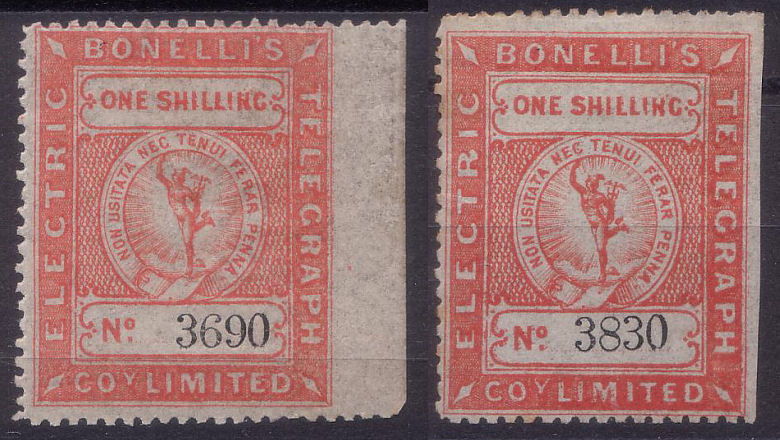
It looks like the right-hand edge was not always perforated, perhaps only after the first 40 sheets. - Centre and right mages courtesy of Steve Lawrie.
The 6d, 19007 shown above shows that they were not always perforated at the top either.
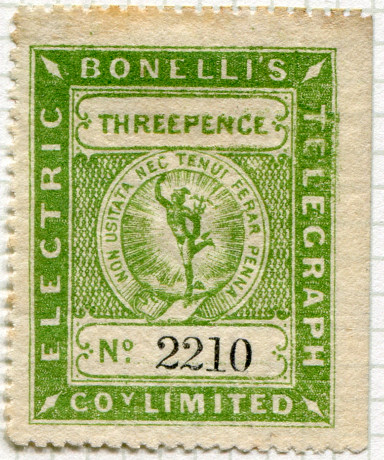
Not just the 1s either. Images of this 3d and 3520 above are courtesy of Grosvenor Auctions.
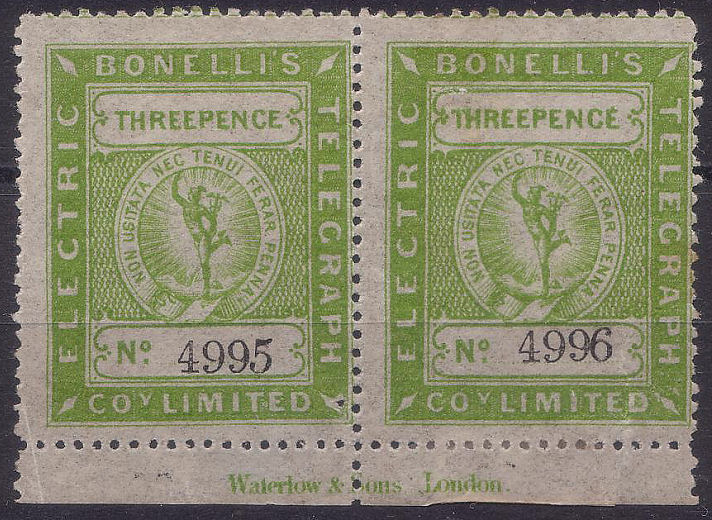 |
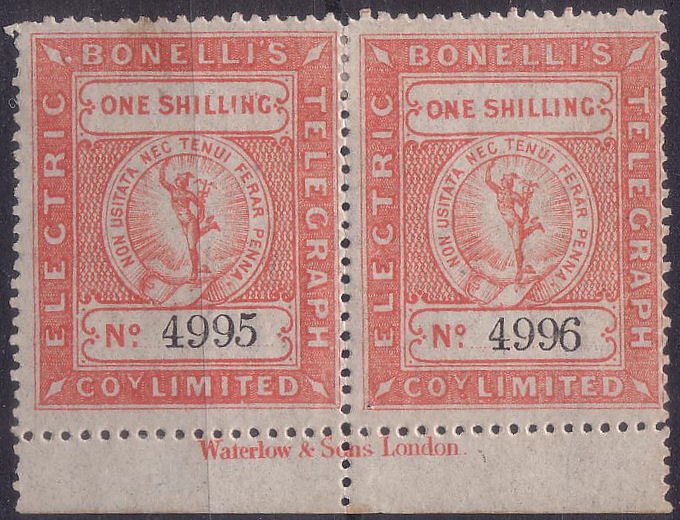 |
|
|
Imprints below stamps not ending with 95 and 96 would easily disprove me.
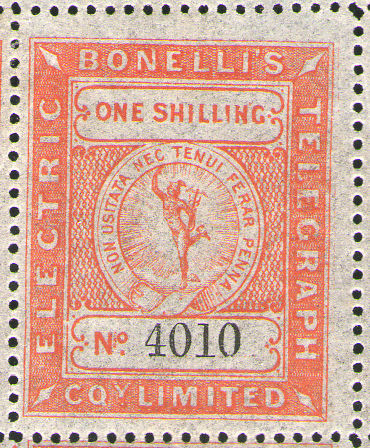 |
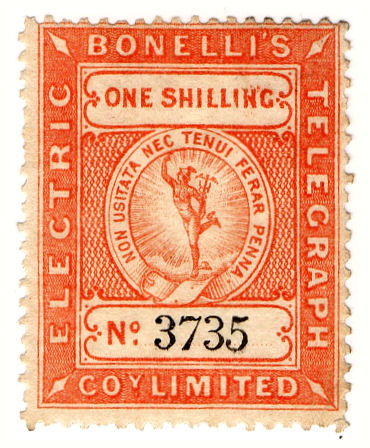 |
| 4010 from my block of 4 below. | 3735 Courtesy of www.ibredguy.co.uk |
| These two have a frame-break just to the left of the serial tablet. | |
The 9d are similarly in rows of 10, but there is a complication with stamp 2/7.
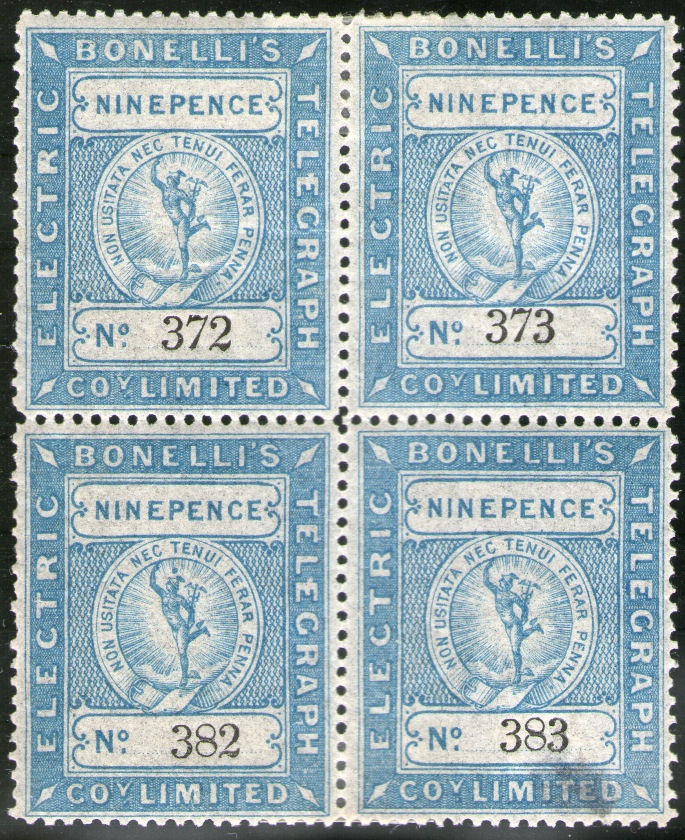 |
||||||||||||||||||||||||||||||||||
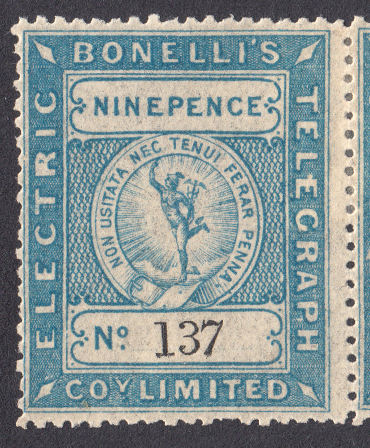 |
||||||||||||||||||||||||||||||||||
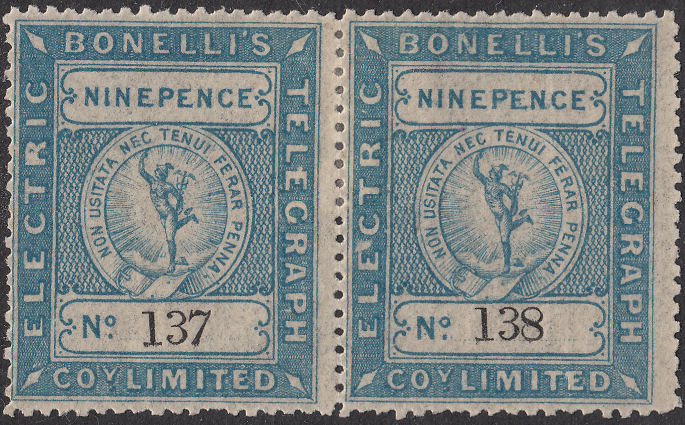 |
This pair is from 5 columns away with the same flaws. I have been looking at all the examples I can find of these for analysis. The table below shows the pattern I have found so far. using '*' to represent dots and 'o' to represent no dots gives this table:
There is still one that I have not yet seen. |
Langmead & Huggins say of Bonelli "no business was ever transacted". This is copied from Lister (1961) who says the same without citing evidence, but adds that they had a single line of 15 wires.
Hiscocks to his credit has found a reference from Walter Morley (1908), suggesting that a few stamps were actually used. This rather implies that at least some business was transacted.
What does the evidence say?
Shades of grey.
Am I the only one that finds it hard to distinguish between the shades of the 6d ?
L&H list 3 printings with the second and proofs in black and the others light grey.
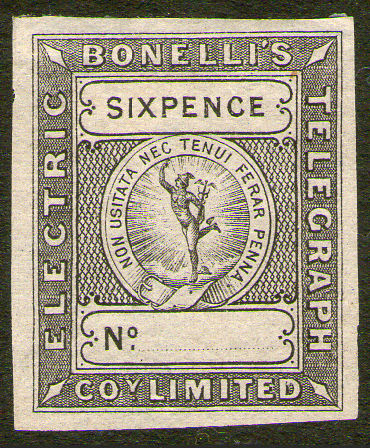 |
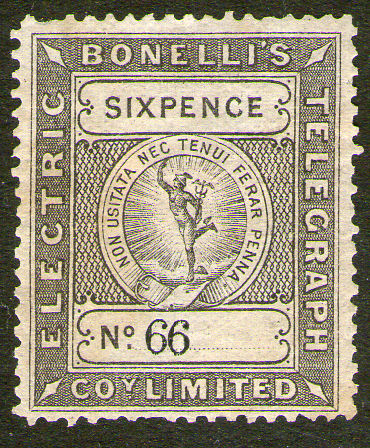 |
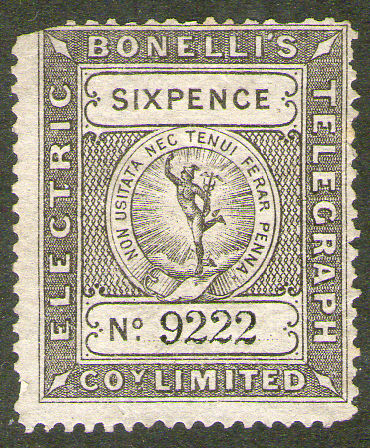 |
| 6d Imperf Proof. Hiscocks H2b Black | 1st.printing. 6d Perf. 12 Hiscocks H2a Light Grey | 1st.printing. 6d Perf. 12 Highest known number, 9222 |
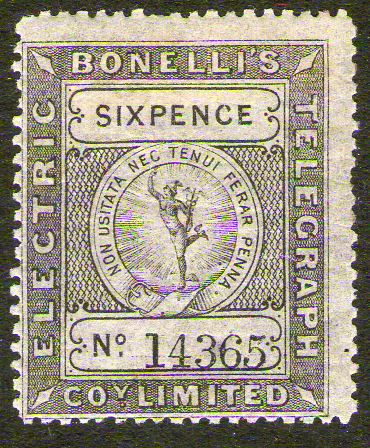 |
 |
| 2nd.printing. 6d Perf. 12¾ Hiscocks H2 Black | 3rd.printing. 6d Perf. 12¾ Hiscocks H2 Light Grey |
| According to Langmead & Huggins the 6d has the following printings: |
|
Anyone know why they needed three printing if supposedly they were never used ?
Personally I see no significant difference between any of these. But then these were all scanned on the same scanner.
Perhaps images created with different scanners would look different. I would like to see both 'shades' scanned side by side together with the same background.
It would have really helped if Langmead & Huggins had quoted lowest numbers seen as well as the highest known number.
If the intention is to find a boundary, there seems little point quoting a 'known up to' figure without a 'known down to' figure also.
Mark Gibson kindly sent me the scans below as an example of the two shades.
However if 18794 is indeed from the 2nd printing then it considerably extends the number of 14387 given.
The 19023 would seem to be from the same sheet as my example above, although the perforations are well shifted!
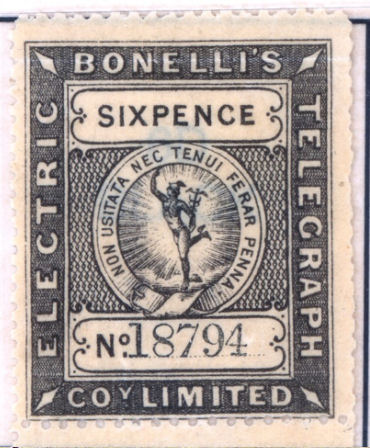 |
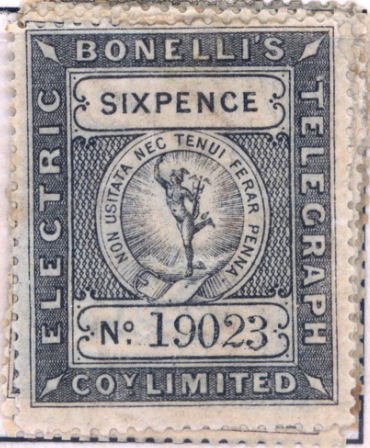 |
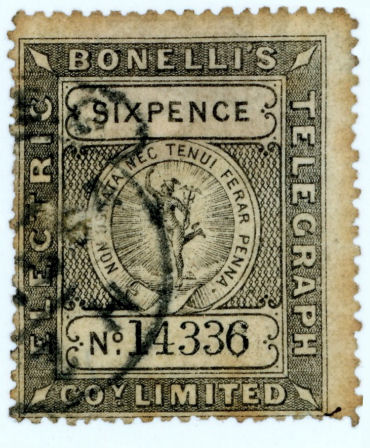 |
| 2nd.printing. 6d control 18794 Black Known up to control 14387 according to L&H ! Puzzlingly, this has the characteristics of a column 1/6 stamp ! See the "6d Anomaly". Now suspected as being a substituted cliché. |
3rd.printing. 6d control 19023 Light Grey | 6d with a London Hooded Circle postmark of 1894 This is from the same sheet as the highest known 2nd. printing according to L&H. |
| Images courtesy of Mark Gibson. | ||
Perhaps it is a mistake to scan these with a black background.
A take away from this though, is why did they need to make 3 printings, totalling 200 sheets or more, if they were never used ?
On top of that they produced at least 18,715 3d booklet stamps each of which had control numbers added by hand.
The 6d, followed by 3d green, followed by 9d and 1s, followed by the 3d booklets (2 types).
That is a lot of production if "no business was ever transacted"!
Evidence comes in many forms. In philately, statistics is very under-utilized.
Philbrick & Westoby (1881) were of the opinion that no Bonelli stamps were ever used. They stated:
"The stamps are readily procurable, having never been employed for telegraph purposes, and having consequently never been used or destroyed."
If that was the case, then a random selection of stamps should be randomly spread across the sheets printed, for any of the face values.
Look at the figures though:
| Value | sheets that examples have been seen from | Sheet Qty | Lowest | Highest | % evident | % missing |
|---|---|---|---|---|---|---|
| 3d green | 0, 2, 21, 22, 23, 38, 42, 43, 45, 49, 50, 51, 55, 68, 84, 85, 97, 98. | 18 | 91 | 9822 | 18.2 | 81.8 |
| 6d black | 0, 56, 59, 75, 84, 92, 110, 129, 142, 143, 182-186, 187, 188-191, 195. | 21 | 30 | 19515 | 10.7 | 89.3 |
| 9d blue | 0-6, 9, 10, 11, 13, 17, 31, 32, 33, 36, 37, 40, 42-47 | 24 | 1 | 4781 | 50.0 | 50.0 |
| 1s red | 17, 27, 29, 32-42, 45, 47, 49 | 17 | 1712 | 4996 | 34.0 | 66.0 |
The objective of the company was to have a 6d standard charge. That undercut their competitors who did their best to close them down.
The low 6d rate though would have been attractive to potential customers. Where did all the missing stamps go ?
Taking the highest number control for each as an indication of the number of sheets printed, together with the number of sheets that I have seen examples from
provides an interesting statistic, though interpretation is less easy.
One interpretation is that the 3d and 6d values were actually used and subsequently destroyed along with used forms,
and that the 9d and shilling values were either not used or little used.
In addition, plate repairs appear to have been made to the 6d before the last sheets were printed.
6d sheets up to sheet 92 at least are Perf.12, sheets 143(98), 184(98) and 187(94) onwards at least have substituted clichés.on the bottom row.
The ones seen are from the bottom row, so bottom row stamps are of interest to see when they were made.
In showing shades above, I came across what appeared to be mis-numbering
Compare these with the '2', '3' and '4' numbered ones above.
Here is 18794 again, together with 18793 which is correct. The alignment of horizontal to vertical perforations at the corners show that they were not adjacent.
18763 and 18793 both have the expected flaw above the 'T' of 'TELEGRAPH'. 18794 doesn't have the expected 'D' flaw at the end of 'LIMITED', but instead has a dot over the 'A' of 'TELEGRAPH'.
Numbers 18702, 18707, 18717, 18727, 18733, 18734, 18738, 18743, 18744, 18763, 18793 on this sheet and 18827, 18835 on the next, are all correct.
Towards 1870 when it became clear that the Private Telegraph Companies would be Nationalised, it was in the interests of those companies to look prosperous to increase the compensation that they received from the Government.
It could be argued that large numbers of stamps could serve that purpose. Indeed it is possible that the 9d and 1s values were produced for that purpose,
but why all the 3d booklet stamps and why bother to do repairs to the 6d plate if they were not being used ?
To me the variation in shade of the later booklet 3d (Hiscocks H5) is much more noteworthy than the 6d, but doesn't get a mention!
These are to the same scale as the ones above. The stamps are longer to allow for a larger control tablet. 18714 below is the highest number I have seen.
With the 3d green, the control numbers were smaller to allow for more digits. The fact that these are re-designed and now the digits are larger has implications.
Presumably the 3d green was produced before booklet stamps were envisaged and the booklets had to be numbered by hand.
This implies that the sheet stamps were numbered by machine.
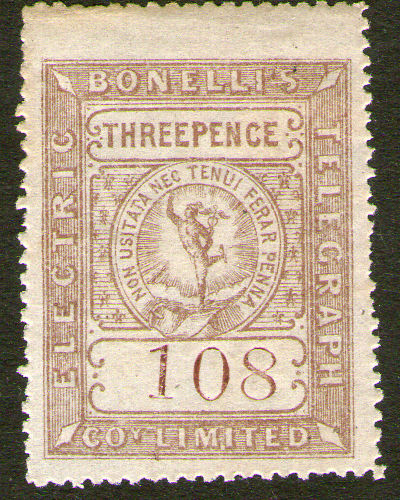
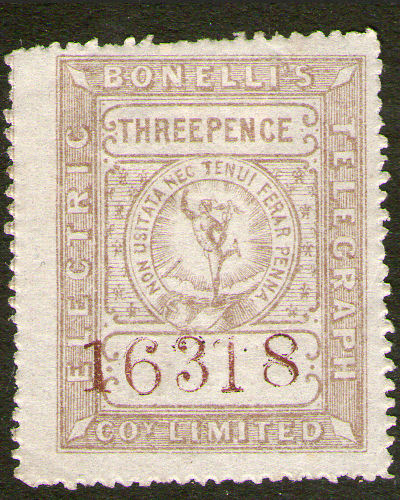
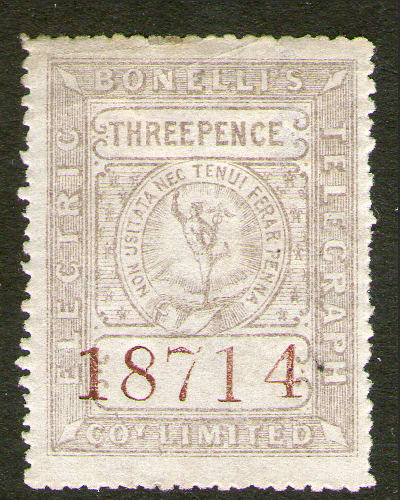
The quality of the perforations is much poorer also. They may be likened to chain-saws.
There were two types of booklets, both had 7 pages with 3 stamps to a row.
One type had 2 rows, the other 4 rows of stamps per sheet and were numbered in a serpentine fashion.
It is generally assumed that Waterlow & Sons produced the booklet stamps as well as the sheet stamps.
I have not seen their imprint on any of the booklet stamps however.
The red numbers are the control numbers modulus 6, explained below.
One thing I find puzzling is that, if we assume these were both panes of 6 stamps, then between them were controls 10021 through 18628.
This represents 8608 stamps (18628 - 10021 + 1). This represents 1434 panes of 6 plus 4 stamps ?
Since these two blocks represent the same positions in a pane, I thought I would compare them for similar details.
This was not simply because I had too much time on my hands. I have been puzzling over LDTC stamps for a while,
it seems that while some make a regular pattern, some do not.
I wondered if it was because some were booklet and some were not. This made me think of the Bonelli's.
Because of the serpentine pattern of the control number, there is no easy way to find position from the control number.
Taking modulus 6 (the remainder left when dividing by 6) of the Control Numbers is helpful.
If the numbering started at control number 1 and the numbering remained consistent, the mod-6 numbering on the
booklet block of 4 above should have started at 1, not 5. It is out of sync by 2.
I refer to this as displacement-2. It will be seen that the displacement varies and the numbering is sometimes NOT consistent.
Here are the most noticeable constant flaws for the repeating unit of 6 stamps.
I have included the mod-6 value, assuming displacement-0, as they presumably started.
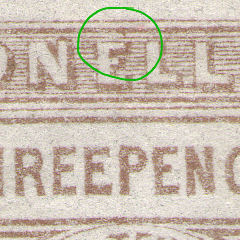 E-flaw-a. Mod 6 = 1 |
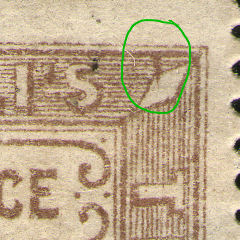 Dagger flaw. Mod 6 = 2 |
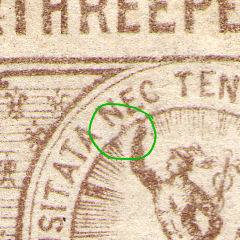 N-flaw. Mod 6 = 3 | 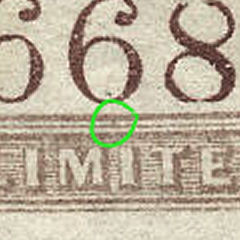 N-flaw alternative. Mod 6 = 3 |
|
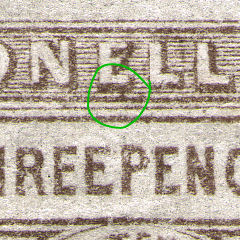 E-flaw-b. Mod 6 = 0 |
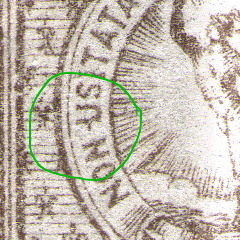 U-flaw. Mod 6 = 5 |
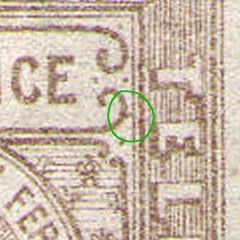 Scroll-flaw. Mod 6 = 4 | The flaw above is on the same stamps as the N-flaw, but the N-flaw is not always clearly visible, so this may sometimes help. It can be seen below on: 1668, 2583 and 13735. |
Control 108 (shown above) has a mod-6 of 0. It does not have E-flaw-b expected, it has the 'dagger-flaw' expected for a mod-6 of 2.
It is displaced forward by 2 so it must be in the 'displacement-2' group.
16318 with mod-6 = 4, correctly has the 'scroll-flaw' and is back in the 'displacement-0' group.
Then 18714 with mod-6 = 0, and the 'dagger-flaw' is in the 'displacement-2' group again.
| Courtesy of Mark Gibson. | Courtesy of Robert Poposki. | Courtesy of Robert Poposki. |
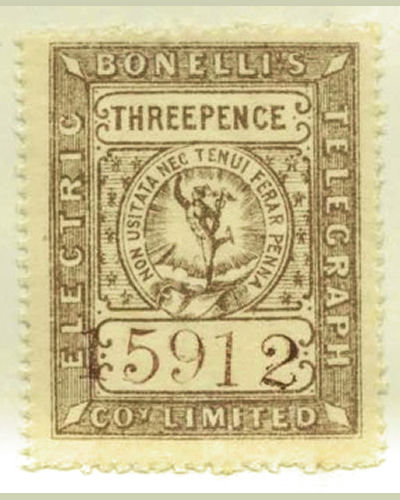 |
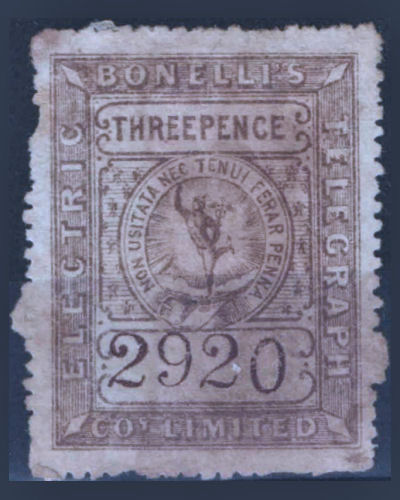 |
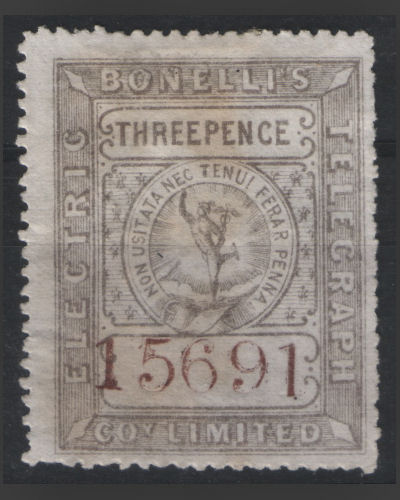 |
| ('displacement-0') Control 15912, Mod-6 = 0 (E-flaw-b) | ('displacement-0') Control 2920, Mod-6 = 4 (scroll flaw) | ('displacement-0') Control 15691, Mod-6 = 1 (E-flaw-a) |
Three more with 'E-flaw-b', 'Scroll flaw' and 'E-flaw-a'. Yeah, I know they're small, but sometimes that's just the way it is.
For those that have found the argument a bit tenuous so far, thankfully I can now show you a booklet pane that makes it more salient
The lowest number on this pane is 18275. The lowest number on the pane above is 15823, a difference of 2452, representing 204 panes of 12 plus 4 stamps.
The argument is about how this 4-stamp anomaly arose and the consequences.
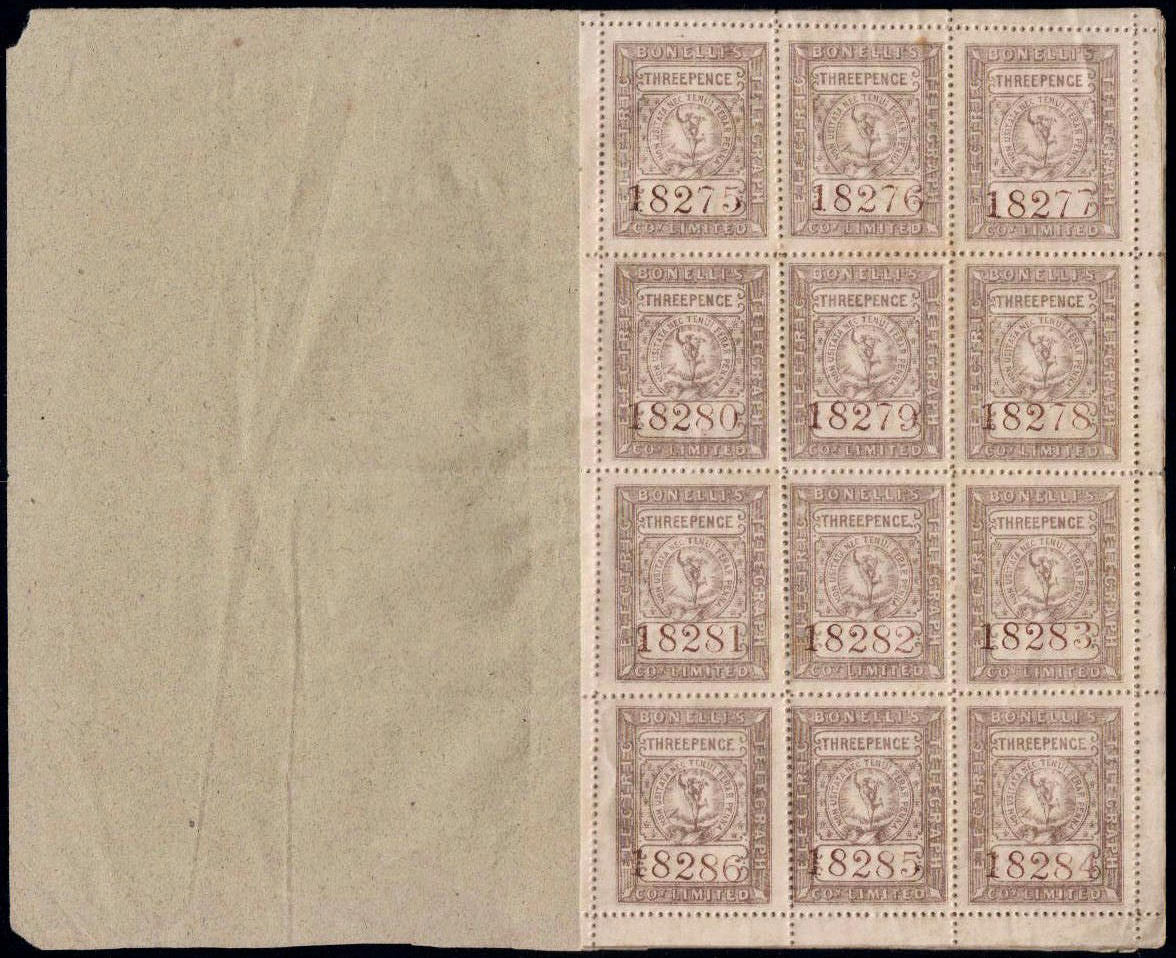
Displacement-2, can you see the two with 'dagger flaws' ? Image courtesy of
Paul Ramsay
These numbers are there for accountancy purposes.
The Victorians took accountancy very seriously and to their credit the numbering is in general very reliable.
4 x 3d = 1/- which is not insignificant in Victorian days, 3d coins were made of silver.
The discrepancy could be the result of one incident or several. Since such incidents seem rare, let us assume for the moment it was just one.
At the moment we know that this discrepancy took place between 16318 and 17141,
a range of 823 stamps or less than 69 sheets, quite a narrow range for more than one mistake.
Off-hand I can think of three possible scenarios:
| 1) Somehow a mistake wasted 4 numbers ( + 0 or more sheets) and numbering was continued without resetting the counter. |
| 2) The numbering machine was used for other things. The counter being set as needed for each job. At one point the counter was set 100 too high (8 sheets + 4 stamps). |
| 3) 4 stamps were numbered 'By Favour' for a V.I.P. or as samples. |
I needed to pin down the boundaries of this first displaced group.
From the images shown so far, I had:
| 1 assumed as 'displacement-0'. |
| 2 - 107 'unknown'. |
| 108 was 'displacement-2'. |
| 109 - 2919 'unknown'. |
| 2920, 10015, 14324, 15691, 15823, 15912, 16318 were 'displacement-0'. |
| 16319 - 18276 'unknown'. |
| 18275, 18629, 18714 were 'displacement-2'. |
| 18715 onwards 'unknown'. |
Clearly more examples were needed.
The examples below helped to narrow these gaps.
 |
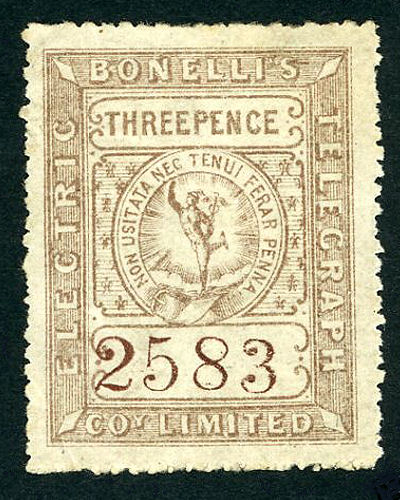 |
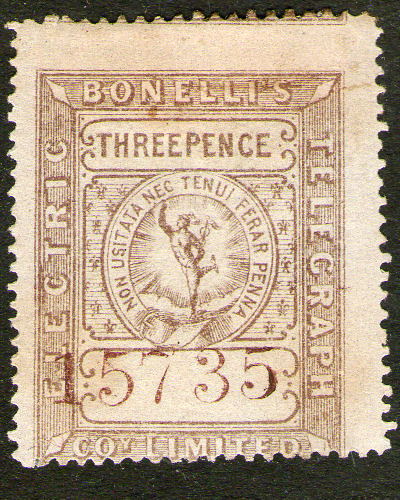 |
| 1746 mod-6 = 0. it shows the 'E-flaw-b' at an early stage. It is another displacement-0 example. |
2583 and 15735 both displacement-0 with a mod-6 of 3. The top of the 'E' in 'Bonelli' and the mark in bottom right diamond are strangely similar to 1746 on the left. On the 'E-flaw-b' these disappear later. Looking for a distinctive flaw they have in common, I see a mark top-right of 'S' in BONELLI'S, and a mark between 'RI' of 'ELECTRIC', But I think the small mark under 'N' of 'NEC', is less likely to be confused when over-inked. I will call it an 'N-flaw'. |
|
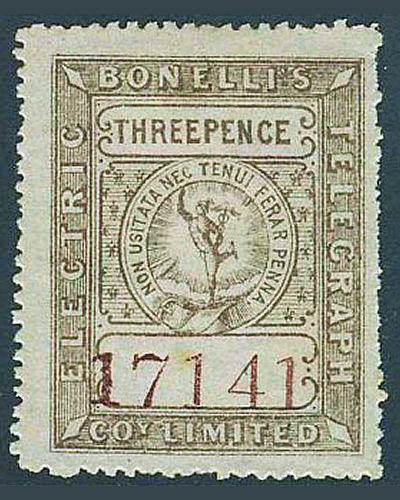 |
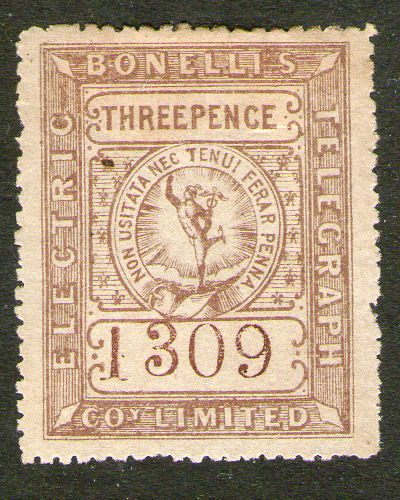 |
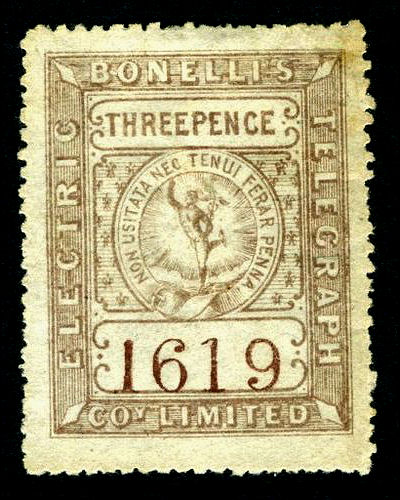 |
| 17141 mod-6 = 5 and has 'E-flaw-a'. It is displacement-2. | 1309 mod-6 = 1 It has the 'Scroll-flaw' expected of mod-6 = 4. The control number is 3 too high. This is displacement-3. |
1619 has a mod-6 = 5 It clearly shows the dagger flaw expected on mod-6 = 2. This is displacement-3. |
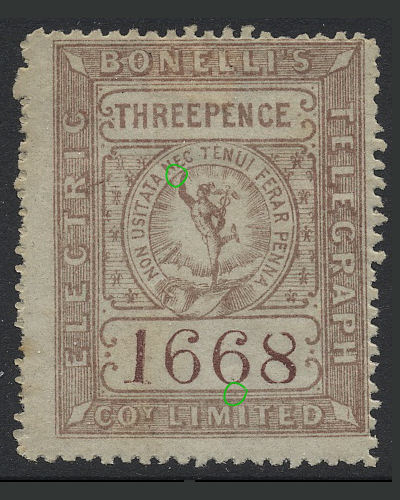 |
||
| E-flaw-b gradually changes as the plate ages. | 1668 (Courtesy of Mike Jackson) had me puzzled for a while. It has the same flaw in the bottom-right diamond as the 3 above. It is between a Displacement-3 and a Displacement-2 group so should have E-flaw-b or N-flaw. But I couldn't see either. Then I noticed the small mark above 'MI' at the bottom. It matches the two above with the N-flaw. Perhaps this flaw first appears somewhere between 1668 and 2583, or perhaps it is weak on this stamp. Anyway, 1668 is in the Displacement-3 group |
|
I have now seen 885, 903, 958, 965 and 1715 all displacement-3, courtesy of Steve Lawrie.
Updating our table gave:
| 1 assumed as 'displacement-0'. |
| 2 - 107 'unknown'. |
| 108 was 'displacement-2'. |
| 109 - 884 'unknown'. |
| 885, 903, 958, 965, 1309, 1321, 1619, 1668, 1715 were 'displacement-3'. |
| 1716 - 1745 'unknown'. |
| 1746, 2583, 2920, 10015, 14324, 15691, 15735, 15823, 15912, 16318 were 'displacement-0'. |
| 16319 - 17140 'unknown'. |
| 17141, 18275, 18629, 18714 were 'displacement-2'. |
| 18715 onwards 'unknown'. |
Any of these ranges may contain pockets of something different
I have included this information in the 'widgit' tool below to help identify flaws, and to help identify further inconsistencies.
I would appreciate information with a scan of any examples that break the known pattern or narrow the boundary areas.
| The fact that I found it hard to get a scan of the top-right stamp of the booklet pane might tempt me to think that it was because they preferentially got used first. However, since everyone knows that the Bonelli's were never used, that cannot be the reason. This last is a test for you, Another (digitally) reunited pair. Are these numbered in the correct sequence? |
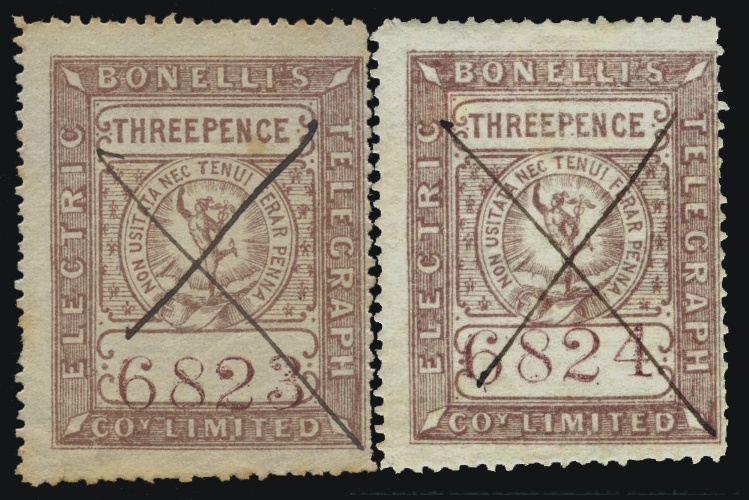 |
| For an alternative explanation see booklet precancels | 6823 Courtesy of Mike Jackson, 6824 Courtesy of Mark Talbot. |
Enter a Control number to check
 |
 |
 |
 |
 |
 |
| Displacement-0 group. | Displacement-1 group. | Displacement-2 group. | Displacement-3 group. | Displacement-4 group. | Displacement-5 group. |
The 'widget' above will correctly show the flaws on 80%+ of the booklet stamps and
show the possibilities for the ones where I have not yet determined the 'displacement'.
It will also flag if the number entered is a new 'highest known' control number.
It did give incorrect results with 2 stamps I tried, one being part of the (digitally) re-joined pair (3521/2 shown lower down).
Please send a scan of any it gives the wrong results for.
An interesting pair of stamps courtesy of Steve Lawrie.
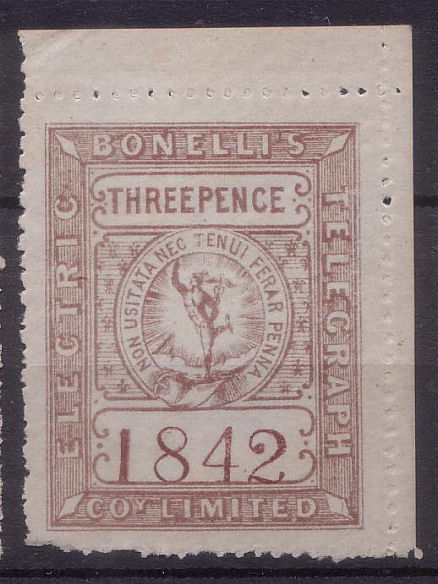 |
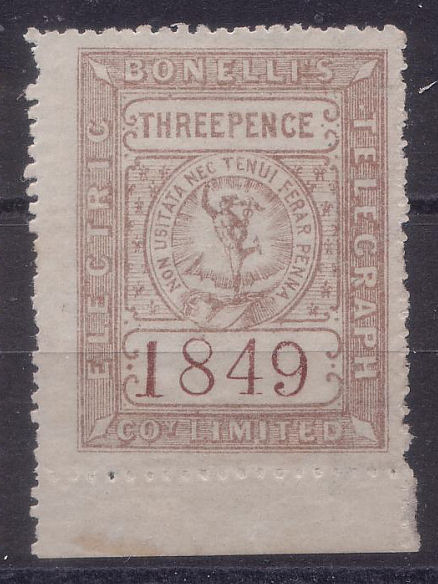 |
||
| 1842 is clearly from the top-right corner of a booklet and the N-flaw can be seen. However 1842 is mod-6 = 0 and should be second row on the left for displacement-0. |
1849 is clearly from the bottom row. It has the E-flaw-b of mod-6 = 0, so was on the left. 1849 is mod-6 = 1 and should be on the stamp above. |
Clearly the normal numbering sequence was not followed on this booklet pane ! Here are 3 possibilities. |
|
It turns out that these are displacement-3 and not serpentine.
Another interesting pair of stamps courtesy of Steve Lawrie.
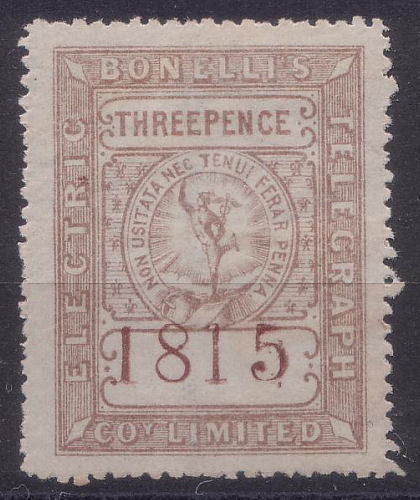 |
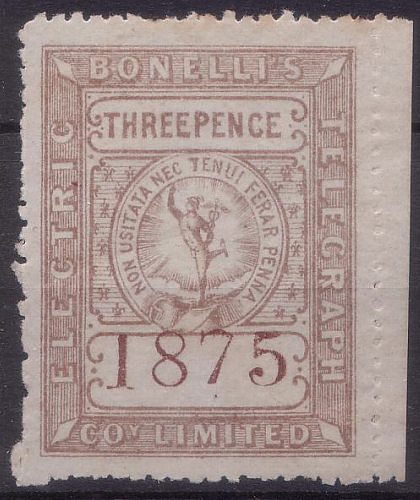 |
|
||||||||||||||||||||||||
| 1815 and 1875 have a lot in common. They are both mod-6 = 3 and have the 'scroll-flaw' that belongs on mod-6 = 4 ! If it had not been for the pair above, I would think they were a new Displacement-1 group, but they are exactly 60 apart and the number half way between, 1845 would be on the pane above. These two should have been 1816 and 1876 respectively. This suggests that 1846 was numbered 1845 similarly. This suggests the numbering scheme shown (or with row 3 reversed). The lowest number, 1840 is mod-6 = 4 instead of mod-6 = 1. This suggests that the range of stamps 1815 to 1875 is in Displacement-3 group. I will update the 'widgit' accordingly. |
||||||||||||||||||||||||||
The ones below add confirmation.
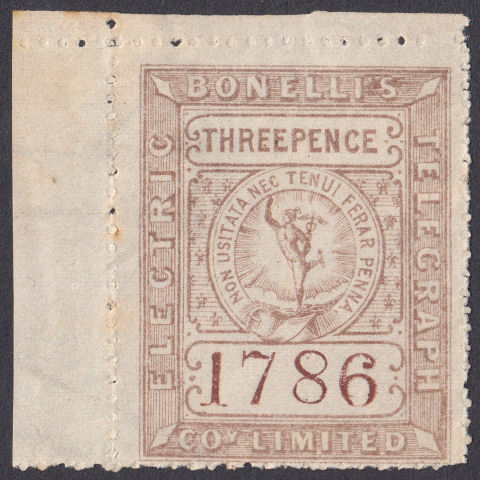 . . . . . |
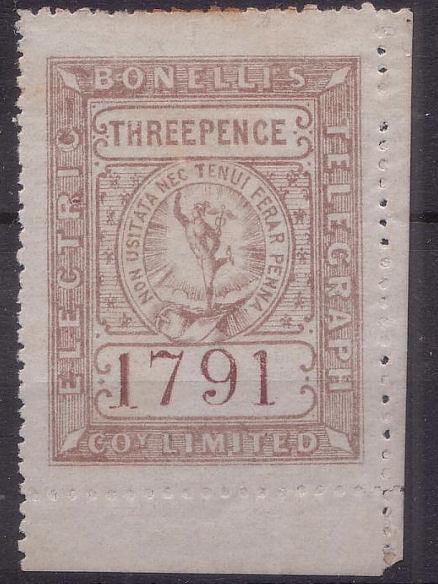 |
1786 (one of mine, E-flaw-a) together with 1791, again courtesy of Steve Lawrie, and 60 stamps before 1851 which would be the bottom right of the pane above. With the scroll-flaw and selvedge, 1791 is clearly from the same position. This is clearly a pane of 6. Altogether then, this mis-numbering, or rather conventional numbering rather than serpentine, probably involves all the stamps in the range 1791 to 1875. Assuming a whole number of panes of 6 are involved, I will take 1786 to 1875 as the minimum range involved.
The anomaly with 1723 would also result from conventional rather than serpentine numbering. |
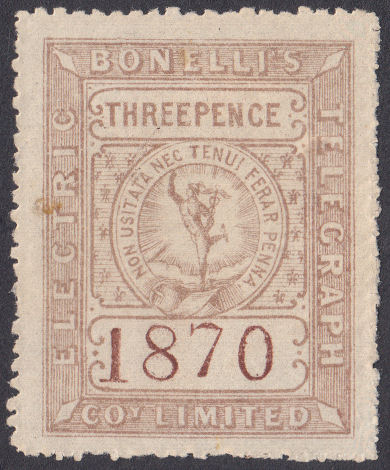 |
1870 (one of mine) has no selvedge but is from the same position as 1786 shown above, 84 (7x12) stamps away. Curiously, although 1786 is clearly from the top-left, these two show no sign of the expected E-flaw-a, or any of the other standard flaws. Other minor blemishes do match them together however. 1875 is shown further up. |
Anyone have any more stamps from this area ?
Other examples:
 |
|
| 3521 is mod-6 = 5 and has the 'USITATA' flaw of mod-6 = 5 as expected for a Displacement-0 stamp. |
3522 is mod-6 = 0 and has the 'Scroll-flaw' of mod-6 = 4 suggesting a Displacement-4 stamp! In fact these have been numbered in the wrong direction, it should have been 3520. |
This (digitally) re-joined pair is a lucky find, without 3521, 3522 would have been hard to explain.
It is from the second row down of a pane of 12 stamps and would normally be numbered right to left.
Part of the next row of stamps can be seen at the bottom. I will take this as spanning the pane of 12 from 3517 to 3528, but will probably be more.
Anyone have any examples from near these?
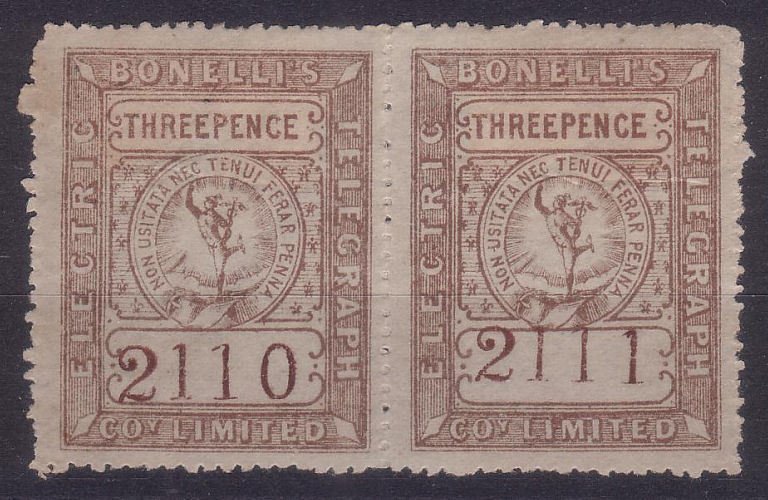 |
|
| 2110 should have the 'Scroll-flaw' of Displacement-0, mod-6 = 4. Instead it has the E-flaw-b that should have been numbered 2112 |
2111 is mod-6 = 5 and has the 'USITATA' flaw as expected for a Displacement-0 stamp. |
2120 has the dagger flaw as it should.
Next Step:
The stamp on the right, courtesy of Steve Lawrie, now became difficult to interpret after the unexpected chaos above. 323 is mod-6 = 5 and in the "no-man's-land" between displacement-2 and displacement-3. We would therefore expect an E-flaw-a or dagger-flaw. Instead it has a clear N-flaw. Should this be interpreted as displacement-4 or a mis-numbered displacement-2 ? Then I saw 340 with a clear Dagger-flaw. This is also consistent with displacement-4. |
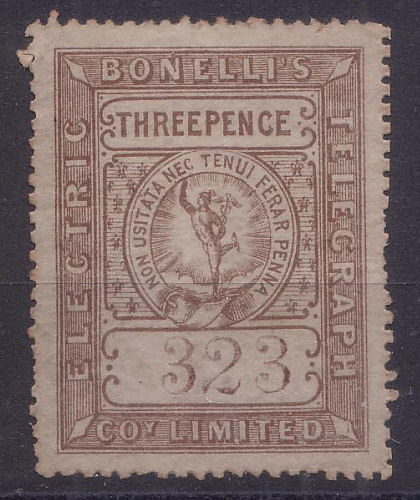 mod-6 = 3 with N-flaw - consistent with displacement-4. |
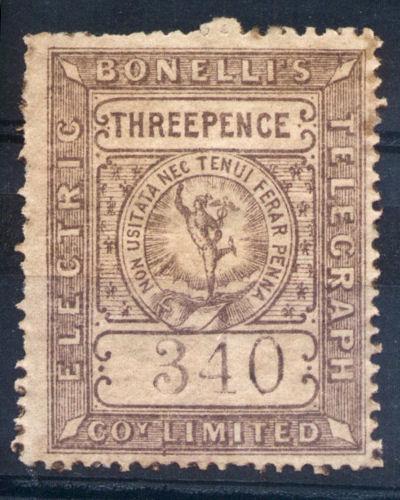 mod-6 = 2 with Dagger-flaw - consistent with displacement-4. |
The bottom row of a pane of 6. It should be numbered right to left.
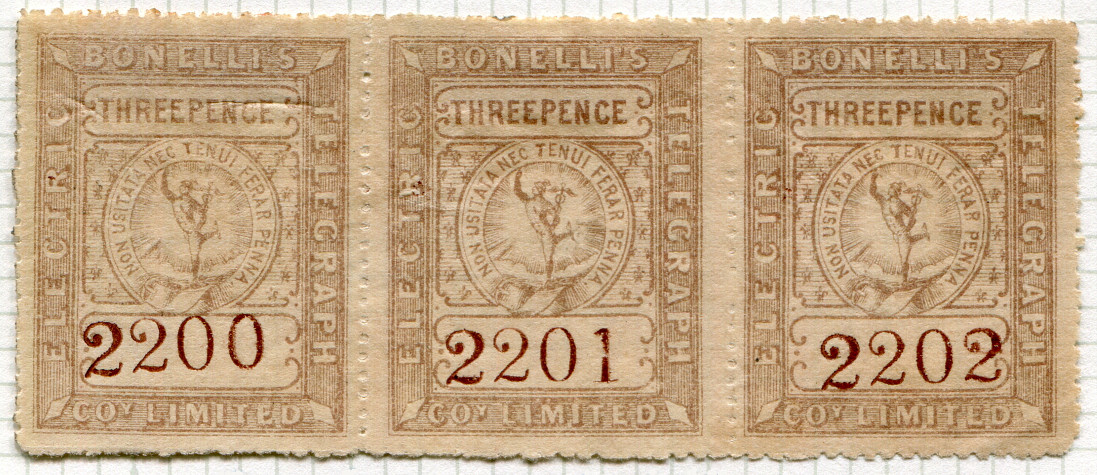
These are conventionally numbered displacement-0 - Courtesy Grosvenor Auctions (Ex. Iain Stevenson).
These, from the Steve Lawrie Collection, continue the story.
| 2215 (E-flaw-a) and 2216 (Dagger flaw) are top-row Displacement-0 group, mod-6 = 4. Since they are top-row, on their own they do not tell us if the numbering was serpentine or conventional. |
2226 is likely to be from the bottom row of the same pane of 12. This has a scroll flaw, so is from bottom-right. |
2922 from about 6 panes away is another E-flaw-a. Again it is Displacement-0, so again we don't know if conventional or not. |
Again 2226 only fits with conventional numbering. With 2922 being so close and also Displacement-0 group, it seems likely to be the same.
I then saw another booklet belonging to Steve Lawrie, numbered 17027 to 17110. Here is the beginning of it:
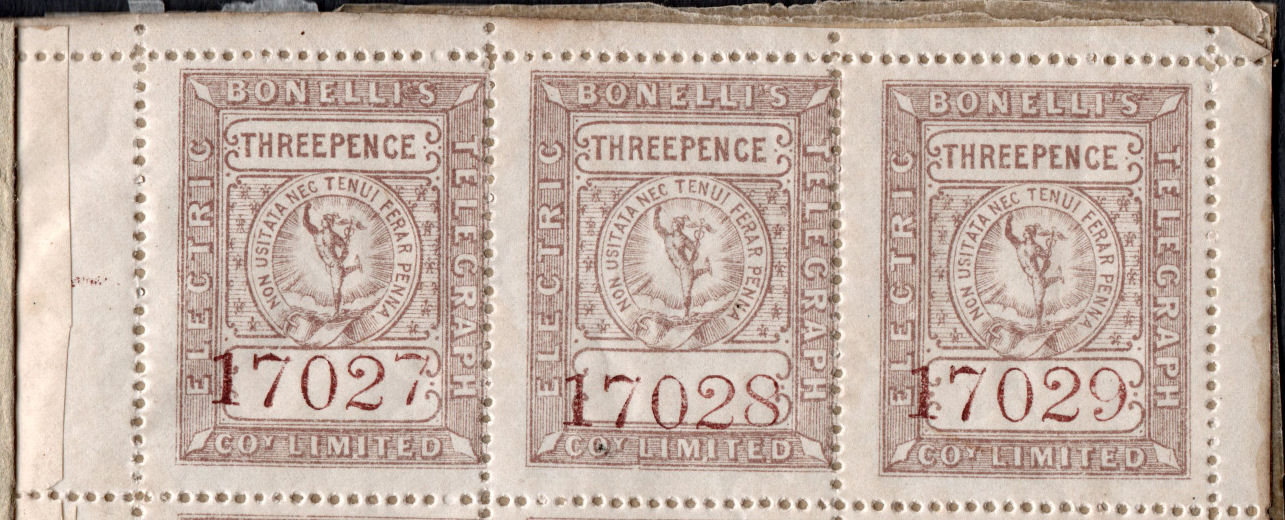
This is a Displacement-2 group. (17029 top-right corner suggests that the panes were guillotined before perforating.)
Updating our table to cover all this gives:
By conventionally I mean that they have been numbered left to right on each row,
instead of the expected serpentine procedure.
Up until now it was assumed that all of these booklet panes were numbered in serpentine fashion.
Close scrutiny shows that there were exceptions.
Why was a serpentine pattern used anyway?
If you are charged with manually numbering an indeterminate number of stamps, quite possibility 100,000 or more,
you will want to make things as easy as possible. There is less movement involved with serpentine numbering, making it quicker.
They were probably not confined to any particular method, as long as they all got numbered differently.
The employee may have followed the conventional numbering until they realised there was an easier way and switched.
Perhaps at times of holidays or sickness a stand-in switched back to the conventional way. We can never know, except perhaps for the first few numbers.
It does complicate things though. I would expect there to be panes of 6 at least with clear conventional numbering, but I have yet to see any !
It must also be realised that the difference between the two systems only switches two stamps out of six, (the E-flaw-b and Scroll-flaw stamps),
so only a third of the stamps would be affected by it.
As a case in point, in the table above 2921 would still have the U-flaw whether it was displacement-0 serpentine or conventional,
though 3516 would change. This makes it harder to decide boundaries.
Langmead & Huggins say they have seen the following booklets of 84 stamps (7 x 12):
14479 - 14562
18863 - 18946
In addition Steve Lawrie has:
15823 - 15906
17027 - 17110
Steve Lawrie's lowest is in a Displacement-0 area, and L&H's low numbers are too.
Steve Lawrie's highest is in a Displacement-2 area.
Taking the last stamps in the booklets:
L & H report "imperf. between in booklets with Controls 2995/3076" (82 stamps).
10003 to 10008 is a booklet pane of six.
Last updated 27th. October 2022
©Copyright Steve Panting 2012/13/14/15/16/17/18/19/20/21/22 except where stated.
Permission is hereby granted to copy material for which the copyright is owned by myself, on condition that any data is not altered and this website is given credit.